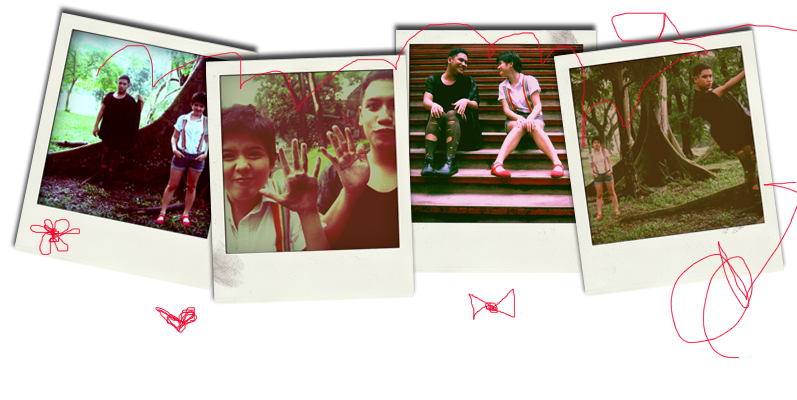To unwound this coil from such a vantage point is not a simplistic redrawing or recharting for the mere sake of keeping account of what had been done. This is not the path that Manuel Ocampo choose to embark on his latest exhibit at Mag:net opening on the 15th of January. Plainly and rather broadly he titles this latest exhibit as The '80s, a time-based clueing-in in his attempt to back track to the time when he started exhibiting regularly in the late '80s.
It's not so much as mere revivalism on what had been the au courant movement at that time which saw the emergence of neo-expressionism, neue wilde German paintings, new subjectivity, neo geo, the tachiste movement , or even the last strains of minimal hi-modernism which was leaning much on optical effects.
The produced paintings for this show will be backdated from 1988-1992, showing signs of wear and taint of its datedness yet imbibed of an incongruence to its historical (factness), "almost antithetical to what was the order of the day - a jovial poetics of dissonance toying with the forms and function of a recycled vernacular inviting a celebratory critique of traditional notions of style (Manuel Ocampo)." They may also be propositions to "some productive tension through a revisitation of the past" But this seems a knowing re-visitation, pushing further the potential possibility of painting then, stretched probably way further than its limit predicated on its lived future. Employing more abstract imagery save for the "cartoon" sperm-like lumps that rises up to an unlit matchstick, amidst a gruel gray void of Acme cosmos and where resurrection seem painless in such a world of an infinite afterlife.
The era referenced was already heavily immersed in "retro revivalism". What was most remarkable was painting's beyond life return from its so-called death just a few years back from its swift pronouncement of its demise (by mostly critics who seem to have merely shackled time and art history to the footfalls of modernism but that too is a dated debacle now .) Kim Levin sees retro revivals as spontaneously generated and hence, instantly obsolete. It is probably in this supposed instant obsolescence that painting was deemed dead and alive and undead all the same time.
Ocampo's works are often characterized by a rabid cannibalizing of recurrent motifs - teeth, bones, limp lumpy dicks, dodos, crows, pierced sausages, leafless trees, anthill caves - painted almost always monochromatically on a heavily stained, splashed, splattered canvas. They can stand in as the cartoon carcass of an "academically" rendered vanitas painting. It's Lazarus bouncing back to a thousand bludgeoning by a cartoon Acme ax.
Maybe for the end times the vanitas or the elements that make up such a painting constitute the total picture which modernism often strive to pictorialize. But absolutes have fettered to uncertainties, more so with agreeing to one grand narrative, which is subscribing to a dogmatic catholic view of painting presaged on its very transubstantiation from form to meaning to symbol.
But Ocampo has gone beyond the obvious allegories of his oft used icons and deigns easy associations:
"the repetition of my work is like the Talmudic cycle of life infinitely re-occurring like a worm from whence the shit came from or vice versa, and never evolving from its state incoherence or incontinence like karmic hell! From this everything loses meaning and the cliche of motif is vexed to the point of abstraction."
In the search for the absolute does what remains is but the essence of its search, the specter of painting at the pronouncement of its "death", the primeval, the unutterable, the formless so vainly entrapped in mannered rendering and painterly style?
Unburdening painting much of this burden is one daunting exercise, to be given back its innocence and purity and liberty for its raw primal uncouth exploration which Ocampo would like to do for this show, via paintings that are small "badly stapled and badly stretched, with frayed edges, cracking, looking unfinished, abandoned, unambitious - nothing particularly striking about them, done quickly like sketches, some layered over old paintings, " painting them all like an amateur wanna-be modern painter from the suburbs, a hobbyist, a weekend painter who just recently joined a community arts and crafts class, all with a "kitschy avant garde" aesthetic, provincial, pedestrian and naive.
This rather conscious refusal or the preference for the otherwise deplorable in a much systematized art industry is Ocampo's commentary on "the bankruptcy of the creative act; or to uncover existential depths and chasms to desecrate the lofty notion of art and to reduce it to somewhat of a hobby, with Hobby as an emancipatory act to resist over professionalization, over commodification and over intellectualization (wanking) of the artworld", as though this would be the come-uppance to a reversed elitism to gain back authenticity or to reclaim the avant garde via conscious amateurism.
It seems full mastery in painting is a lifelong vocational dilettantism where no absolute end is mete out for painting to remain forever resurrected, undead, perpetually invoked despite the fickleness of anathemic tides.
article from: Magnet Galleries
 |
| installation view |
 |
| 1989 represent! |
all photos by: Veronica Peralejo







No comments:
Post a Comment